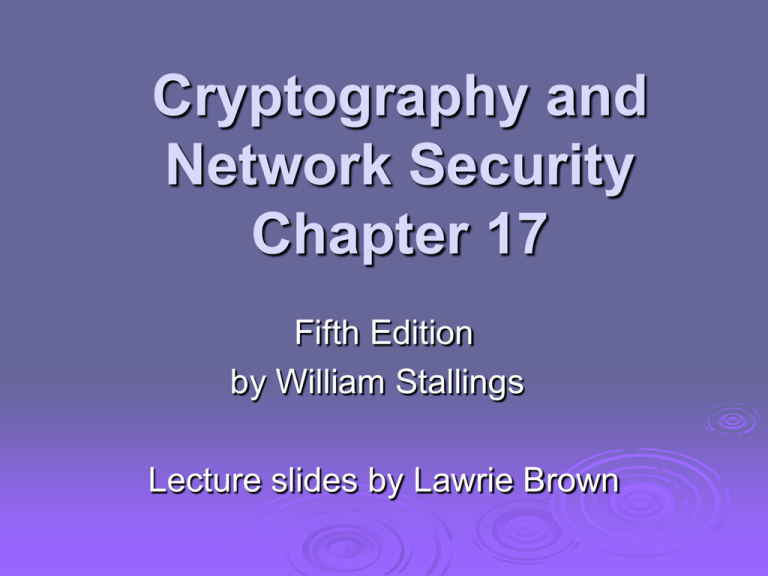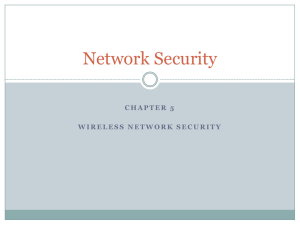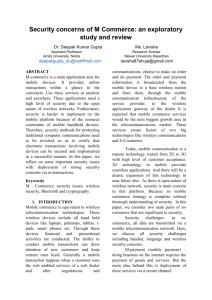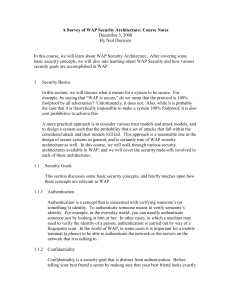William Stallings, Cryptography and Network Security 5/e
advertisement

Cryptography and Network Security Chapter 17 Fifth Edition by William Stallings Lecture slides by Lawrie Brown Chapter 17 – Wireless Network Security Investigators have published numerous reports of birds taking turns vocalizing; the bird spoken to gave its full attention to the speaker and never vocalized at the same time, as if the two were holding a conversation Researchers and scholars who have studied the data on avian communication carefully write the (a) the communication code of birds such has crows has not been broken by any means; (b) probably all birds have wider vocabularies than anyone realizes; and (c) greater complexity and depth are recognized in avian communication as research progresses. —The Human Nature of Birds, Theodore Barber IEEE 802.11 IEEE 802 committee for LAN standards IEEE 802.11 formed in 1990’s charter to develop a protocol & transmission specifications for wireless LANs (WLANs) since then demand for WLANs, at different frequencies and data rates, has exploded hence seen ever-expanding list of standards issued IEEE 802 Terminology Access point (AP) Any entity that has station functionality and provides access to the distribution system via the wireless medium for associated stations Basic service set (BSS) A set of stations controlled by a single coordination function Coordination function The logical function that determines when a station operating within a BSS is permitted to transmit and may be able to receive PDUs Distribution system (DS) A system used to interconnect a set of BSSs and integrated LANs to create an ESS Extended service set (ESS) A set of one or more interconnected BSSs and integrated LANs that appear as a single BSS to the LLC layer at any station associated with one of these BSSs MAC protocol data unit (MPDU) The unit of data exchanged between two peer MAC entites using the services of the physical layer MAC service data unit (MSDU) Information that is delivered as a unit between MAC users Station Any device that contains an IEEE 802.11 conformant MAC and physical layer Wi-Fi Alliance 802.11b first broadly accepted standard Wireless Ethernet Compatibility Alliance (WECA) industry consortium formed 1999 to assist interoperability of products renamed Wi-Fi (Wireless Fidelity) Alliance created a test suite to certify interoperability initially for 802.11b, later extended to 802.11g concerned with a range of WLANs markets, including enterprise, home, and hot spots IEEE 802 Protocol Architecture Network Components & Architecture IEEE 802.11 Services 802.11 Wireless LAN Security wireless traffic can be monitored by any radio in range, not physically connected original 802.11 spec had security features Wired Equivalent Privacy (WEP) algorithm but found this contained major weaknesses 802.11i task group developed capabilities to address WLAN security issues Wi-Fi Alliance Wi-Fi Protected Access (WPA) final 802.11i Robust Security Network (RSN) 802.11i RSN Services and Protocols 802.11i RSN Cryptographic Algorithms 802.11i Phases of Operation 802.11i Discovery and Authentication Phases IEEE 802.1X Access Control Approach 802.11i Key Management Phase 802.11i Key Management Phase 802.11i Protected Data Transfer Phase have two schemes for protecting data Temporal Key Integrity Protocol (TKIP) s/w changes only to older WEP adds 64-bit Michael message integrity code (MIC) encrypts MPDU plus MIC value using RC4 Counter Mode-CBC MAC Protocol (CCMP) uses the cipher block chaining message authentication code (CBC-MAC) for integrity uses the CRT block cipher mode of operation IEEE 802.11i Pseudorandom Function Wireless Application Protocol (WAP) a universal, open standard developed to provide mobile wireless users access to telephony and information services have significant limitations of devices, networks, displays with wide variations WAP specification includes: programming model, markup language, small browser, lightweight communications protocol stack, applications framework WAP Programming Model WAP Infrastructure Wireless Markup Language describes content and format for data display on devices with limited bandwidth, screen size, and user input capability features include: a text / image formatting and layout commands deck/card organizational metaphor support for navigation among cards and decks card is one or more units of interaction a deck is similar to an HTML page WAP Architecture WTP Gateway WAP Protocols Wireless provides applications two session services connection-oriented and connectionless based on HTTP with optimizations Wireless Transaction Protocol (WTP) manages transactions of requests / responses between a user agent & an application server provides an efficient reliable transport service Wireless Session Protocol (WSP) Datagram Protocol (WDP) adapts higher-layer WAP protocol to comms Wireless Transport Layer Security (WTLS) provides security services between mobile device (client) and WAP gateway provides data integrity, privacy, authentication, denial-of-service protection based on TLS more efficient with fewer message exchanges use WTLS between the client and gateway use TLS between gateway and target server WAP gateway translates WTLS / TLS WTLS Sessions and Connections secure connection a transport providing a suitable type of service connections are transient every connection is associated with 1 session secure session an association between a client and a server created by Handshake Protocol define set of cryptographic security parameters shared among multiple connections WTLS Protocol Architecture WTLS Record Protocol WTLS Higher-Layer Protocols Change simplest, to make pending state current Alert Cipher Spec Protocol Protocol used to convey WTLS-related alerts to peer has severity: warning, critical, or fatal and specific alert type Handshake Protocol allow server & client to mutually authenticate negotiate encryption & MAC algs & keys Handshake Protocol Cryptographic Algorithms WTLS authentication uses certificates • X.509v3, X9.68 and WTLS (optimized for size) can occur between client and server or client may only authenticates server WTLS key exchange generates a mutually shared pre-master key optional use server_key_exchange message • for DH_anon, ECDH_anon, RSA_anon • not needed for ECDH_ECDSA or RSA Cryptographic Algorithms cont Pseudorandom HMAC based, used for a number of purposes only one hash alg, agreed during handshake Master Function (PRF) Key Generation of shared master secret master_secret = PRF( pre_master_secret, "master secret”, ClientHello.random || ServerHello.random ) then derive MAC and encryption keys Encryption with RC5, DES, 3DES, IDEA WAP End-to-End Security have security gap end-to-end at gateway between WTLS & TLS domains WAP2 Endto-End Security WAP2 End-toEnd Security Summary have considered: IEEE 802.11 Wireless LANs • protocol overview and security Wireless Application Protocol (WAP) • protocol overview Wireless Transport Layer Security (WTLS)










